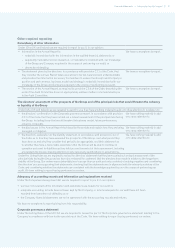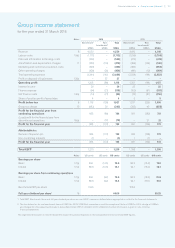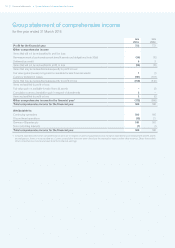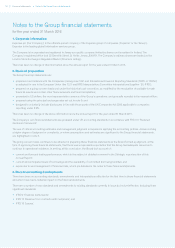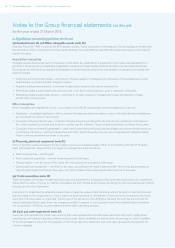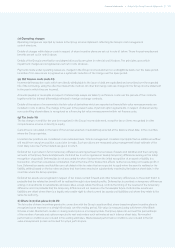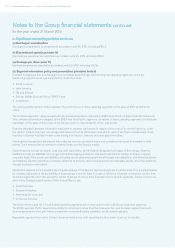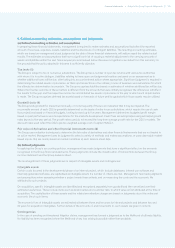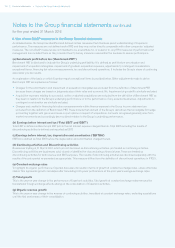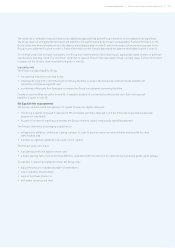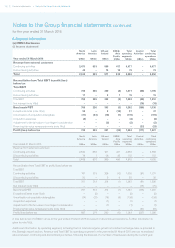Experian 2016 Annual Report Download - page 122
Download and view the complete annual report
Please find page 122 of the 2016 Experian annual report below. You can navigate through the pages in the report by either clicking on the pages listed below, or by using the keyword search tool below to find specific information within the annual report.
120
Notes to the Group financial statements continued
for the year ended 31 March 2016
Financial statements •Notes to the Group nancial statements
4. Significant accounting policies continued
(e) Goodwill (note 19) and Other intangible assets (note 20)
Experian follows EU-IFRS, including IAS 38 ‘Intangible assets’. Gains and losses on the disposal of undertakings are stated after
the elimination of the carrying amount of goodwill relating to the undertakings sold, allocated where necessary on the basis of
relative fair value.
Acquisition intangibles
Intangible assets acquired as part of a business combination are capitalised on acquisition at fair value and separately from
goodwill, if those assets are identifiable (separable or arising from legal rights) and their fair value can be measured reliably.
Such assets are referred to as acquisition intangibles in these financial statements. Amortisation is charged on a straight-line
basis as follows:
• Customer and other relationships – over three to 18 years, based on management’s estimates of the average lives of such
relationships, and reflecting their long-term nature.
• Acquired software development – over three to eight years, based on the asset’s expected life.
• Marketing-related assets (trademarks and licences) – over their contractual lives, up to a maximum of 20 years.
• Marketing-related assets (trade names) – over three to 14 years, based on management’s expected retention of trade
names within the business.
Other intangibles
Other intangibles are capitalised at cost, in accordance with IAS 38. Capitalisation and amortisation policies are:
• Databases – capitalised databases, which comprise the data purchase and capture costs of internally developed databases,
are amortised over three to seven years.
• Computer software (internal use) – computer software licences purchased for internal use are capitalised on the basis of
the costs incurred to purchase and bring into use the specific software. These costs are amortised over three to ten years.
• Computer software (internally generated) – costs directly associated with producing identifiable and unique software products
controlled by the Group, and that will generate economic benefits beyond one year, are recognised as intangible assets.
These costs are amortised over three to ten years.
(f) Property, plant and equipment (note 21)
Items of property, plant and equipment are held at cost less accumulated depreciation, in accordance with IAS 16 ‘Property,
plant and equipment’. Depreciation is charged on a straight-line basis as follows:
• Freehold properties – over 50 years.
• Short leasehold properties – over the remaining period of the lease.
• Finance leases – over the lower of the useful life of the equipment and period of the lease.
• Owned plant and equipment – over three to ten years, according to the asset’s estimated life. Technology-based assets are
typically depreciated over three to five years, with other infrastructure assets depreciated over five to ten years.
(g) Trade receivables (note 22)
Trade receivables are initially recognised at fair value and subsequently measured at this value less any provision for impairment.
Where the time value of money is material, receivables are then carried at amortised cost using the effective interest rate method,
less any provision for impairment.
A provision for impairment is established when there is objective evidence that the Group will not be able to collect all amounts
due according to their original terms. Such evidence is based primarily on the pattern of cash received, compared to the terms
upon which the receivable is contracted. The amount of the provision is the difference between the carrying amount and the
value of estimated future cash flows. Any charges or credits in respect of such provisions and irrecoverable trade receivables
are recognised in the Group income statement, within other operating charges.
(h) Cash and cash equivalents (note 23)
Cash and cash equivalents include cash in hand, term and call deposits held with banks and other short-term, highly liquid
investments with original maturities of three months or less. Bank overdrafts are shown within borrowings in current liabilities
on the Group balance sheet. For the purposes of the Group cash flow statement, cash and cash equivalents are reported net
of bank overdrafts.



